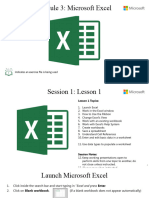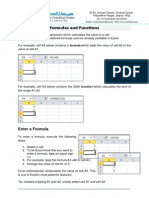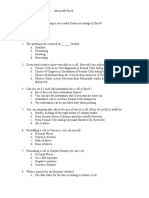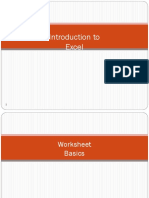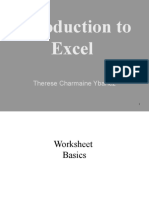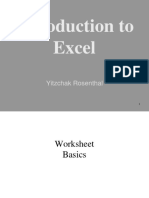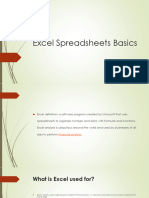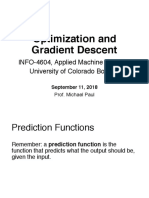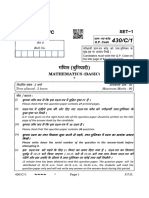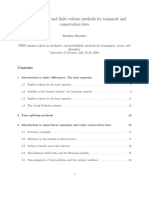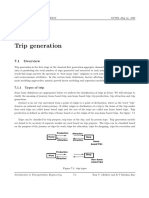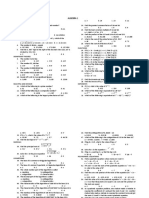Introduction to Excel
�Worksheet Basics
�Worksheets
Excels main
screen is called a worksheet.
Each worksheet is
comprised of many boxes, called cells.
�Organize Information
You can organize
information by typing a single piece of data into each cell. (see next slides)
�How to Enter Information
�Selecting a Cell
Select a cell by
clicking on it once (dont double click).
You can move
from cell to cell with the arrow keys or by pressing the Enter key.
6
�Entering Information / The Formula Bar
To enter information in
a cell, just start typing.
When you are done
either
Press the Enter Key Press an arrow key Click on the check
button (only visible when entering data into a cell)
The information in the
selected cell is also displayed in the formula bar above the worksheet.
7
�Double Click to Modify a Cell
To modify the
contents of a cell double click on the cell. Then use the right, left arrow keys and the Insert and Delete keys to modify the data. When you are done:
Press the Enter key
Double click to change hi there to hello there
or Click on the check box.
8
�Names of Rows, Columns and Cells
�Column Names (letters) & Row Names (numbers)
The columns of
the worksheet are named with letters The rows are named with numbers
Selected Cell
10
�Cell Names (ex. B4)
The name of a cell is a combination of the Letter Of The Column that the cell is in followed by the Number Of The Row that the cell is in. Example: the selected cell in the picture is named B4 (NOT 4B)
Name Box
Selected Cell
Excel automatically shows the the name of the currently selected cell in the name box (located above the worksheet).
The letter must come first (i.e. B4, NOT 4B) and there may NOT be any spaces between the letter and the number. We will learn later why it is important to understand how to name cells.
11
�Longggggggg Data
12
�Information that is too wide for a cell
The word Name is in cell
A5 The words Hours Worked are in cell B5 (NOT in cell C5). However, since the information is too wide for cell B5, it looks like it extends into cell C5. You can determine that the information is really only IN cell B5 by selecting cell B5 and looking at the formula bar and then selecting cell C5 and looking at the formula bar.
13
Hours Worked is in cell B5 (look at formula bar)
Hours Worked is NOT in cell C5 (formula bar is empty)
� If there is
Information that is Choppedthe Off You can see
complete data by selecting the cell and looking in the formula bar.
information in the cell to the right, then the original cell still contains all of the data, but the data appears to be chopped off.
14
�Change the Width of a Column or the Height of a Row
15
�Make a column wider
To make Column B wider,
Drag column separator to the right
point the cursor to the column separator between columns B and column C. The cursor changes to a Double headed arrow. Now, click the left mouse button and without letting go of the button, drag the separator to the right to make the column wider
(or to the left to make the column narrower).
16
Column is now wider
�Getting the Exact Width
To get the exact width,
Double click here
double click on the separator instead of dragging it.
Column is now EXACTLY the correct width
17
�Resizing a Row
Make a row
taller or shorter by dragging the separator between the rows.
Row is now taller
Click and
drag here to resize row 5.
18
�Putting an Enter inside a cell
To add a new line
Step 1: Originally Hours Worked is on one line.
inside a cell
Double click inside
19
the cell where you want the new line. Press Ctrl-Enter (i.e. hold down the Ctrl key and press Enter while still holding down Ctrl). When you are done editing, press Enter (without holding down Ctrl) to accept the changes.
Step 2: Double click to edit cell and then press Ctrl-Enter
Step 3: Press Enter (without Ctrl) to accept the changes.
�Basic Formatting (e.g. bold, colors, fonts, etc)
20
�Formatting Cells
Select one or more cells and then click on any of the formatting buttons
(see below) to change the formatting of the selected cells. Formatting buttons: show fewer decimal points (ex.
10.507 is displayed as 10.51)
These change the way numbers are displayed in cells. (these dont affect words).
show more decimal points (ex. 10.507 is displayed as 10.5070) indent within cell put border around cell(s) color of cell color of text in cell
center font name font size left justify right justify
bold italics
click on downward pointing arrows for other font names and sizes
center & merge cells (will explain later)
remove indent
show with commas (e.g. 12345 becomes 12,345) click on downward pointing arrows for other colors and border styles
underline
21
show as percent (ex. 0.5 becomes 50%) show as currency (ex. 1000.507 becomes $1000.50)
�Example unformatted worksheet
Unformatted worksheet see next slide for
formatting.
22
�Example making cells bold
Click on cell A1 and drag to cell A3. Then press the Bold button to make cells A1,A2,A3 bold. You could also press the font or background color buttons to change
the color or apply any other formatting you like (this is not shown below).
23
�Other Ways of Selecting More Than One Cell
To select a large range of cells, click on the upper
left cell in the range. Then hold the shift key and click on the lower right cell in the range. You can select different non-contiguous areas of cells by holding down the Ctrl key while clicking and dragging.
24
�Selecting Non-Contiguous Ranges
Click and
drag to select the first range.
Ctrl-click
and drag to select additional ranges
25
(This cell is also selected even though it appears white).
�Selecting entire Rows, entire Columns or all cells on the worksheet.
To select an entire column, click on the letter for
the column header. To select several columns, click on the header for the first column and drag to the right. To select an entire row, click on the number for the row header. To select several rows, click on the header for the first row and drag down. To select all of the cells on the spreadsheet, click on the upper left hand corner of the spreadsheet (where the column headers meet the row headers)
26
�Select Entire Columns/Rows/Worksheet
To select ENTIRE COLUMN B
click on B column header
To select ENTIRE ROW 2
click on 2 row header
Click
Click
To select ROWS 2,3 and 5,6,7 To select COLUMNS B,C,D
click on B column header and drag to right
click on 2 row header, drag down, then Ctrl-Click on 5 row header and drag down
Click
drag
Click and drag down then Ctrl-Click and drag down
To select COLUMNS B,C and F,G,H
click on B column header, drag to right,
then Ctrl-Click on F column header and drag right CtrlClick Click drag drag
To select ENTIRE WORKSHEET
click on select worksheet button (in Click corner between 1 and A buttons)
27
�Example - continued
Step 1: Click on row header for row 5 Step 2: Ctrl-click on row-header for row 11
Step 3: Press Bold button or type ctrl-b
Note: After being bolded, the word Employee is now too wide for the column, so make the column wider if necessary (this step is not 28 shown).
�More Advanced Formatting
29
�Format Cells
Using the formatting buttons only
give you a limited amount of formatting ability. For more formatting ability, select one or more cells and right click on the selection. Then choose format cells from the popup menu. Choose options from the Number, Alignment, Font, Border and Patterns tabs and press OK to change the way your information looks on the screen. The Protection tab is used to lock cells so that their contents cant be modified. We will not go into the details of using the format cells dialog box 30 this time but you should be at able to figure out most of it by
�Formatting changes how things LOOK, not how they WORK.
NOTE: you will probably not understand this slide
until after you learn about Excel Formulas. Formulas are covered later in this presentation. When you change the format of a cell, Excel still remembers the original value. Excel will use the un-formatted value when calculating formula values. Example: if you change numbers to appear with fewer decimal points the original number with all of its decimal points are used in calculations.
31
�Formulas
The bread and butter of Excel
32
�Excel Formulas
You must have an equals sign ( = ) as the first
character in a cell that contains a formula. The = sign tells excel that the contents of the cell is a formula Without the = sign, the formula will not calculate anything. It will simply display the text of the formula.
33
�Formulas - correct
formula with = sign After pressing ENTER
34
�Missing = sign
Missing = sign! Before pressing enter After pressing ENTER (no change - not a function)
35
�Types of operations
You can use any of the following operations in a
formula: operation
symbol
example
=a1+3 =100-b3 =a1*b1 =d1/100 =a2^2 =-a2+3
addition: + subtraction: multiplication: * division: / exponentiation ^ negation (same symbol as subraction)
36
�Explicit (literal) values and cell references
You can use both explicit values and cell
references in a formula An explicit value is also called a literal value
Formula with only cell references: Formula with only literal values:
=a1*b1 =100/27
Formula with both cell references and literal values:
=a1/100
37
�Errors in Formulas
38
�Common Errors
The following are some errors that may appear in a spreadsheet (there
are others too).
####### Cell is too narrow to display the results of the formula. To fix this simply make the column wider and the real value will be displayed instead of the ###### signs. Note that even when the ###### signs are being displayed, Excel still uses the real value to calculate formulas that reference this cell. #NAME? You used a cell reference in the formula that is not formed correctly (e.g. =BB+10 instead of =B3+10) #VALUE! Usually the result of trying to do math with a textual value. Example: =A1*3 where A1 contains the word hello #DIV/0! Trying to divide by zero. Example: =3/A1 where A1 contains 0 (zero) Circular Reference Using a formula that contains a reference to the cell that the formula lives in. Example: putting the formula =A1+1 in cell A1 or putting the formula =SUM(A1:B2) in any of the cells A1, B1, A2, B2
39
�Order of Operations
40
�Complex formulas
You can use several operations in one
function You can group those operations with parentheses
Examples
=3*2+1
=c1*(a1+b1)
=(100*a2-10)+(200*b3-20)+30
41
=(3+2*(50/b3+3)/7)*(3+b7)
�Order of operations
When using several operations in one formula,
Excel follows the order of operations for math.
first: second: third:
all parentheses - innermost first exponents (^) all multiplication (*) and division (/). these starting with the leftmost * or / and work to the right. all addition (+) and subtraction (-). these starting with the leftmost + or
Do
fourth:
Do 42
and work to the right.
�Please Excuse My Dear Aunt Sally
The sentence "Please excuse my dear aunt Sally"
is a popular mneumonic to remember the order of operations: Menumonic
Please Excuse My Dear
Meaning
parentheses exponents mulitplication and division (going left to right) addition and subtraction (going left to right)
Aunt Sally
43
�Order of operations
The value of
3+2*5 is 13 NOT 25!
44
�Order of operations
3 + (100 - 20) / 10 - 6 * 2 / 4 + 9 3 + 80 / 10 - 6 * 2 / 4 + 9 3+ 8 - 6 * 2 / 4 + 9 3 + 8 - 12 / 4 + 9 3+8 - 3 + 9 11 - 3 + 9 8+9
45
answer:
17
�Cntrl-`
To see the formulas in the worksheet
Press the Cntrl key at the same time as you press
the ` key (i.e. Cntrl-`) Press Cntrl-` again to see the values
46
�Functions
47
�What is a function?
A function is a "named operation"
Functions have
a name parentheses parameters/arguments inside the parentheses The words parameter and argument mean the same thing you can have many parameters for one function separated with commas (,) The number of parameters is one more than the number of commas.
48
�The SUM function
Examples
Function
=SUM(1,2,3,4,5) 15
Result
=SUM(a1,b1,c1)
=SUM(9,a1,b2,5,c1)
a1+b1+c1
9+a1+b2+5+c1
49
�Terminology SUM(1,2,3,4,5)
The name of the function is "SUM" The parameters or arguments to this function are 1,2,3,4
and 5
The entire thing, i.e. SUM(1,2,3,4,5), is a function call The value of this function call is 15.
Another way to say this is that this function call returns 15.
50
�Ranges (e.g. a1:c3)
51
�Ranges
A rectangular box of cells is called a range. The name of a range is the name of the upper left cell of the range Followed by a colon : Followed by the lower right cell of the range Example: A1:B2 is shorthand for A1,A2,B1,B2 See next slide for more examples
A1:B2
52
�Examples of Range Names
Examples
C3:E10
B2:B5
B3:E3
53
�Using a range as a parameter
Ranges can be specified as a parameters to a
function call. Both of the following function calls produce the same result as =a1+b1+c1+a2+b2+c2+a3+b3+c3+a4+b4+c4 however the 2nd version uses a range and is much shorter.
without a range =SUM(a1,b1,c1,a2,b2,c2,a3,b3,c3,a4,b4,c4)
54
with a range
�Function calls with multiple parameters
You can include multiple ranges and cells as
parameters
Example: the following function call has 3
parameters. There are two ranges (a1:b2 and c4:c7), one number (100) and one cell reference (d3) =SUM(a1:b2,100,c4:c7,d3) Is the same as:
55
=SUM(a1,a2,b1,b2,100,c4,c5,c6,c7,d3)
�Other Functions
56
�Other functions
Click the function button to see the available
functions:
Function buton brings up the function dialog box (see next slide)
57
�Warning: this slide was created using Excel 2000. The dialog box in later versions of Excel looks a little different, but it has the same functionality.
Function dialog
Functions for the selected category
box
categories (i.e. groups of functions)
Description of currently selected function
58
�Function Editor
Double click on the function name to get a dialog
box that helps you enter values for the parameters of the function. (see next slide)
59
�Function Editor Put values for the parameters in
the edit boxes.
When you press OK, this will create the function call: AVERAGE(2,a1:c2,f13)
60
�Example
AVERAGE
formula that contains a function
=AVERAGE(2,4,10,4) =AVERAGE(a1,f32) =AVERAGE(a1:c1) =AVERAGE(a1:c1,10)
value
5 (a1+f32) / 2 (a1+b1+c1) / 3 (a1+b1+c1+10) / 4
61
�Combining Functions and other values in a single formula
62
�Functions and other values
You can combine functions, cell references and
literal values to make a complex Excel formula Examples
=3 + b23 * SUM(d20:g20) =SUM(a1,100) * AVERAGE(d10:j10) =100 / ( AVERAGE(b2,c2,d30) + AVERAGE(f1:f20) )
63
�Other Types of Cell References
References to entire ROWs References to entire COLUMNs References to cells or ranges on other worksheets (i.e. tabs)
64
�Entire Rows (e.g. 2:2 or 2:4)
A cell reference of the form <rowName>:<rowName> refers to
the range of all the cells for those rows.
Example: The reference, 2:2, refers to all of the cells on the 2nd row. The following formula adds up all of the values on the 2nd and 4th rows of the spreadsheet:
=sum(2:2,4:4)
Another Example: The reference, 2:4, refers to all of the cells on the 2nd , 3rd and 4th rows,. The following formula adds up all of the values on the 2nd, 3rd, 4th , 10th, 11th , 12th, 13th, 14th and 15th rows of the spreadsheet:
65
=sum(2:4,10:15)
�Entire Columns (e.g. B:B or B:D)
A cell reference of the form <colName>:<colName> refers to
the range of all the cells for those columns.
Example: The reference, B:B, refers to all of the cells in the 2nd column. The following formula adds up all of the values in the 2nd and 4th columns of the spreadsheet:
=sum(B:B,D:D)
Another Example: The reference, B:D, refers to all of the cells in the 2nd, 3rd and 4th columns. The following formula adds up all of the values in the 2nd, 3rd, 4th, 6th and 7th columns of the spreadsheet:
66
=sum(B:D,F:G)
�References to cells on other worksheets
Cell on another sheet: sheetName!cellReference Range on another sheet: sheetName!range Row on another sheet: sheetName!row:row Column on another sheet: sheetName!column:column
If a sheet name has a space in it, you must
surround the sheet name with apostrophes (i.e. single quotes)
Examples
sheet2!a1 sheet2!b4:c8 '2002 Forecasts'!f3:f10 =sum('2002 Forecasts'!f3:f10)
67
�More examples
Add up values from 2 different sheets
=sum ( 'great stocks'!b2:c4, 'so so stocks'!b2:c4)
This next one is a little confusing
=sum (a1,a!a1,b1:b4,b1!b4,c!c:c)
Explanation
a1 a!a1 sheet b1:b4 b1!b4 "b1" sheet c!c:c this is a cell reference on the current sheet "a" is the name of sheet. "a1" is a cell on the "a"
this is a range on the current sheet "b1" is the name of a sheet. "b4" is a cell on the c" is the name of a sheet. c:c" is all of the cells
68
�Absolute and Relative Cell References
69
�Absolute and Relative Cell References
By default, when you copy a formula that contains
a cell reference, excel will automatically adjust the cell reference.
You can stop Excel from automatically adjusting
the cell reference by using one or more dollar signs ($) in the cell reference. These are called absolute cell references.
A cell reference without a dollar sign is a relative
cell reference.
70
�Examples
The following all refer to the same cell
d9 $d$9 $d9 d$9
The only difference between these cell references
relates to what happens when you copy a formula that contains the cell reference.
71
�Relative Cell Reference
d9
This is a "relative cell
reference".
Changing the column: If I copy this cell reference to
another cell:
the "d" will increment one letter for every cell that I move
over to the right. The "d" will decrement one letter for every cell that I move over to the left
Changing the row: If I copy this cell reference to
another cell:
the "9" will increment by one for every cell that I move
down. The "9" will decrement by one for every cell that I move up
72
�Absolute cell reference
$d$9
This is an absolute cell
reference.
If I copy a formula with this cell reference, the cell
reference will NOT change AT ALL.
73
�Mixed References
$d9 and d$9
These are "Mixed" cell
references:
$d9
The "d" will stay the same when you copy the cell,
but the "9" will change.
d$9
The "d" will change when you copy the cell, but the
"9" will stay the same.
74
�Data Types
75
� Numeric
Data Typesnumber values: any
+ * / ^ sum( ), average( ), max( ), min( ) etc. %
operators: sample functions:
Text (AKA Character or String)
values:
Any group of letters or numbers or special characters. Prefix value in cell with an apostrophe ( ' ) to force a text
value operators: sample functions:
Dates
values:
& (concatenation) right( ), left(), mid(), lower(), upper(), len(), etc
operators: sample functions:
dates and times N/A now( ), today( ), hour(), minute(), etc.
Logical (AKA boolean)
values:
76
Operators:
true <
false >
<>
<=
>=
�Data Types for Values in Cells
By default:
a cell that contains a number is treated as numeric
data a cell that contains a date is treated as date data (we'll see more about this later) a cell that contains data which is not numeric and not a date is treated as "text"
77
�Text Data
78
�Text / String / Character
The following three terms all used to refer to "text"
data. All three terms mean the same thing.
text data string data
character data
This presentation will generally use the term "text
data" but you should be familiar with the terms "string data" and "character data"
79
�Text data
Text data is used to store general purpose text
(e.g. names, places, descriptions, etc)
You can't do "math" with text values (obviously)
80
�Text isn't part of numerical calculations (obviously)
Formula to add up all numbers in column C
formula view (press Cntrl-`)
(Same Spreadsheet)
values view (press Cntrl-`)
Text data in C1 is not included in the Sum
81
�Text Functions
82
�Text Functions
Many functions are used to manipulate text
values. The following are only some of them
right( ) left( ) mid( ) concatenate( ) lower( ) upper( ) len( )
83
�RIGHT, LEFT and MID functions
84
�RIGHT function
The RIGHT function is used to isolate a specific
number of characters from the right hand side of a text value. (example on next slide)
85
�RIGHT ( <text>, <numCharacters>)
Formula View
Values View
86
�RIGHT numCharacters is optional
The <numCharacters> parameter in the RIGHT function
is optional. If you dont specify it the default is 1 (one).
Formula View
Values View
87
These produce the same results.
�LEFT
The LEFT function is the same as the RIGHT
function, but it returns characters from the LEFT side of the value.
88
�MID ( <text>, <startPosition> , <numCharacters>)
MID is used to get values from the middle of
some text.
MID takes 3 parameters:
The original text The position to start taking the new value from The number of characters to take for the new value
Example on next slide
89
�Example: MID ( <text>, <startPosition> , <numCharacters>)
This example extracts the second through the
fourth characters from the original text value:
Formula View
Values View
90
�Concatenation ( & ) and CONCATENATE function
91
�Concatenation (&)
Use & to combine (or concatenate) two different text values
Formula View
Values View
Notice that there is no space between the two values
92
�Concatenate many values
You may concatenate many values together
Formula View
Values View
93
�Concatenation with "literal" values
You can also concatenate "literal" values.
You must include the literal values inside quotes
For example to display spaces in the "full name"
in the previous example you could use the following formula. Each space that you want to display must be included in quotes. =A2&" "&B2&" "&C2
(Don't forget any of the &'s )
See next slide ...
94
�Concatenating spaces - Example
You can concatenate spaces into a formula
Formula View
Values View
values contain spaces
95
�LEFT( ) with results of different function calls & in same formula You can combine the
with concatenation.
Formula View
Values View
96
�Putting itwe concatenate periods into the initials. all together In this example
Formula View
Values View
The initials now contain periods
97
�CONCATENATE Function
You can use the CONCATENATE function instead
of the ampersand (&). The following formulas are equivalent:
=A1&B1&C1 =CONCATENATE(A1,B1,C1)
The CONCATENATE function can take as many
parameters as you like.
98
�More Text Functions: LOWER UPPER LEN
99
�LOWER ( <textValue> ) UPPER ( <textValue> )
LOWER converts text to lower case.
UPPER converts text to upper case.
Example:
Formula View
Values View
100
�LEN ( <textValue> )
LEN returns a numeric value equal to the number
of character in a text value (i.e. the length of the text value). Spaces ARE included in the length. Example
Formula View
101
Values View
�Dates and Times
102
�How Excel Stores Dates
Dates are stored in Excel as the number of days since Dec
31, 1899 for that date. (ex. Jan 1, 1900 is stored as the number 1). To see this, type a date in a cell and then press Ctrl-` to see the formulas view. Example
Values View
Dates become numbers in formulas view
Formulas View
103
�Times and Dates in the same Cell
A cell can contain both a date and a time.
The value of both the date and the time is stored internally as a single
decimal number.
The whole number portion represents the DATE and is the number of
days since Dec. 31, 1899
The decimal part represents the TIME and is the fraction of the day that
has elapsed.
Examples:
Jan 1, 1900 at 12AM is 1.0 (i.e. 1 day since Dec 31, 1899 and 0 percent of the
day elapsed so far)
Jan 1, 1900 at 12PM is 1.5 (i.e. 0.5 of the day elapsed) Jan 2, 1900 at 12PM is 2.5 (i.e. 2 days since Dec. 31, 1899)
104
Feb 1, 1900 at 1:05 PM is 32.5451388888889 (i.e. 32 days since Dec 31,
�Times and Dates - Example
Values View
Formulas View
105
�Date Arithmetic
You can do arithmetic with dates. Add and subtract days by adding and subtracting
whole numbers. Add and subtract times by adding and subtracting fractional values.
Examples
=A1+7 =A1-5*7 =A1- (1/24) =A1+ (3/24) =A1+2.5 =A1-A2+1
106
(one week after the date in A1) (5 weeks before the date in A1) (one hour before the time specified in A1) (three hours after the time specified in A1) (two and a half days after the time specified in A1) (the # of days between the date in A1 and the date in A2)
�Formatting cells with Dates and Times
Right click on the cell and
choose Format Cells From the Category list in the Number tab either
Choose Date, Time or
Custom and choose an appropriate looking format OR
If you choose General or
107
Number, the internal number for the Date/Time will be displayed in the spreadsheet even in the values view.
�Logical (AKA boolean) values
108
�TRUE and FALSE
A logical value can be one of only two values
TRUE
or
FALSE
109
�TRUE
The following statements are TRUE:
Fish live in water. Deer live on land.
The following statements are also TRUE:
3 is greater than 2 2 is less than 3 2 is less than or equal to 3 2 is less than or equal to 2 3 is greater than or equal to 2 3 is greater than or equal to 3 2 is equal to 2 2 is not equal to 3
110
�FALSE
The following statements are FALSE:
Fish live on land. Deer live in water.
The following statements are also FALSE:
111
2 is greater than 3 3 is less than 2 3 is less than or equal to 2 2 is greater than or equal to 3 2 is equal to 3 2 is not equal to 2
�Logical operators
In Excel the following "operators" are used
Operator Meaning > greater than < less than >= greater than or equal to <= less than or equal to = equal to <> not equal to
Examples
3>2 3<2 true false
112
�Logical Formulas
Formula View Values View
113
�Same formulas, different values
Formula View Values View
114
�IF Function
115
�Parameters for IF function
116
�IF function
Formula View Values View
117
�IF with a numeric result
118
�IF with a numerical result
Formula View Values View
119
�AND
OR NOT
120
�AND
The following is TRUE
Fish live in water AND deer live on land.
The following are all FALSE
Fish live in water AND deer live in water. Fish live on land AND deer live on land. Fish live on land AND deer live in water.
121
�AND function
122
�AND
Formula View
Values View
123
�IF with AND - nested function calls
You can use an AND inside of an IF.
This is called a NESTED FUNCTION CALL
Example
=IF( AND (A2>A3,B2<>B3) , 500, 1000)
AND is "nested" inside of the IF
124
These parentheses "belong to" the if
�IF with AND - parameters
Parameters for IF function:
125
�IF with AND - spreadsheet views
Formula View Values View
126
�AND function
Takes any number of parameters
Returns TRUE if ALL of the parameters evaluate
to TRUE otherwise returns FALSE.
127
�OR and NOT functions
128
�OR
Takes any number of parameters
Returns TRUE if ANY of the parameters evaluate
to TRUE otherwise returns FALSE
129
�NOT
Takes ONLY ONE parameter
Returns the "opposite" of the value of the
parameter
returns FALSE if the parameter value is TRUE returns TRUE if the parameter value is FALSE
130
�Examples of Complex Nested Function Calls
=IF(AND(A2>A3, OR(B2=B3,C2<C3)), 500, 1000)
=IF(NOT(AND(A2>A3, OR(B2=B3,C2<C3))), 500,
1000)
=IF(AND(A2>A3, NOT(OR(B2=B3,C2<C3))), 500,
1000)
131
�Other Logical Functions: ISBLANK
132
�ISBLANK( <value> )
ISBLANK returns TRUE if the value is blank and false
otherwise. (see example below)
Formula View
Total will be correct even if quantity is blank (quantity is assumed to be 1 in that case)
Total will be wrong if quantity is blank (since a blank is normally treated as zero)
Values View
blank value
133
�APPENDICIES
134
�Using the mouse to create formulas.
135
�Click to choose cell references
Once you type the equal sign (=) you can click
with your mouse to enter cell references into a formula.
Now you can click with your mouse to enter cell references.
Example on following slides
136
�Example: click to get cell reference
Type a number in cell A1 Type a plus sign (+) sign
and the dashed line around cell A1 disappears.
type an equal sign (=) in B1 You can continue to fill out
the rest of the formula now:
Click on cell A1. You will see
137
a dashed line around cell A1 and the text A1 (without the quotes) will be entered into the formula in B1. The dashed line indicates that this is the cell reference being entered.
Press ENTER to get the
result:
�Example: changing the cell reference
Type numbers in cells A1 and
Click cell B1. The dashed line moves to
B1
cell B1 and the text in cell C1 changes to B1. You can keep clicking on different cells until you click on the right one.
Type an equal sign (=) in C1
Type a plus sign (+) sign. The dashed
line around cell B1 disappears.
Click on cell A1. You will see a
dashed line around cell A1 and the text A1 (without the quotes) will be entered into the formula in C1. The dashed line indicates that this is the cell reference being entered.
138
If you click on another cell now, a new
cell reference will be entered.
You can continue to fill out the rest of
the formula now
�Use mouse to enter other types of cell references.
Cell ranges:
Click and drag on a cell to enter a cell range reference
Cells on a different worksheet
Click on a cell on another worksheet to enter a
reference from a different worksheet. Be sure to type the next symbol in the formula (e.g. a plus sign (+) , a comma (,) , etc before you click on the original tab. If you dont then the formula will be incorrect (try it).
139
�FORMATTING A CELL AS TEXT
140
�Numbers with have to have zeroes displayed at the beginning of a leading zeros Sometimes you desire to
number. For example, US social security numbers are made up of 9 digits. The first few digits may be zeroes. This causes in a problem in Excel. When you type in a number with leading zeroes into a cell, Excel removes the leading zeroes when you press Enter.
EXAMPLE:
If you type the following into a cell (before you press Enter)
When you press Enter you get this:
Leading zeroes are missing
141
�Formatting a cell to display as text
To fix this problem you can format the cell to
142
display as text instead of as a number. The value will still be able to be used in calculations but it will be displayed on the screen using the rules for text values instead of the rules to display numbers One of the rules Excel uses to displaying numbers is to remove leading zeroes. However, if a number displayed as "text" data then Excel WILL display leading zeros. See next slide for instructions on how to do this
�Opening the "Format cells" dialog box
Select the cell or cells that you want to format
as text. Right click on the selected cell(s) and choose the following from the popup menu format cells
or click on a cell and choose the following menu choice format | cells
Then you will see the "Format Cells" dialog
143
box.
�"Format Cells" dialog box
Choose
"Text" from the "Number" tab and press the OK button.
144
�Not a Perfect Solution
When you format the cell as text it will display
the leading zeroes (you must type them in again). However, Excel will warn you that a number is formatted as text. (see next slide)
145
�Result of Formatting a Number as Text
Excel indicates this issue
with a green triangle in the upper left hand corner of the cell:
If you select the cell you
can see the error message.
You can have Excel to
ignore this type of error by choosing the Tools | Options menu choice and unchecking the Number stored as text option from 146 Error Checking tab. the (this solution is not shown
�Another Option using an Apostrophe ()
147
�Force a Cell to Display as Text by Using an Apostrophe (')
Another way to display leading zeroes in a
number is to type an apostrophe as the first character in the cell. When you press Enter, the apostrophe is NOT displayed in the cell (it is displayed in the formula bar). The apostrophe tells Excel that the contents of the cell should be treated as text. The apostrophe is similar to the = sign.
The = sign tells Excel that the cell contains a
148
formula. The apostrophe () tells Excel that the cell contains
�Results of Using an Apostrophe
Type an apostrophe
followed by the SSN. Before pressing Enter you can see the apostrophe. After pressing Enter you cant see the apostrophe anymore and leading zeroes remain. However, Excel will warn you that a number is formatted as 149 text via the green
�Ignoring numbers in calculations
150
�Ignoring numbers in calculations
Typing an apostrophe () as the first character in a
cell with a number has the additional effect of causing the number to be ignored in calculations.
NOTE: This does not happen when you format
the cell that contains a number to display as text.
151
�Ignoring numbers in calculations.
By default, all numbers are included in
numeric calculations. However, you can force a cell that contains a number to be treated as text and not be included in calculations with numeric functions
(ex. SUM, AVERAGE, etc.) by placing
an apostrophe as the first character in the cell
152
�Example
Formula to add up all numbers in column D
formula view (press Cntrl-`)
(Same Spreadsheet)
values view (press Cntrl-`)
The Year is incorrectly included in the sum.
153
�Example - continued To fix the problem you can This will force
add an apostrophe (') before the data for the year (no space necessary after the apostrophe). the number to be treated as text (see next slide).
NOTE: When you stop editing the cell, the apostrophe will NOT be visible in the spreadsheet. However, it will be visible in the formula bar.
154
�Example - finished
The number for the year is now treated as text and is not included in the sum. The apostrophe in not visible in the spreadsheet (unless you're editing the cell). The apostrophe IS visible in the formula bar.
155
�The End
Slides after this one are in progress you can ignore them
156
�TODO
- Finish editing the following slides
- Move apostrophe stuff to the appendix
157
�Nested IF Functions
TODO: add slides for nested IFs
158
�Entering values in multiple sheets at once.
159
�Cell Names
160
�Cell Names
Insert | Name | Create
161
�PROTECTING A WORKSHEET / WORKBOOK
162
�Advanced Formatting
163
�TODO: fill out this section
TODO: fill out this section
Using format cells dialog box Conditional Formatting Data validation
164

